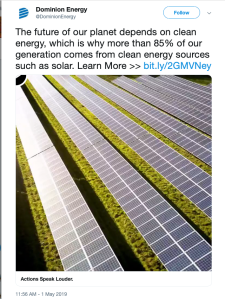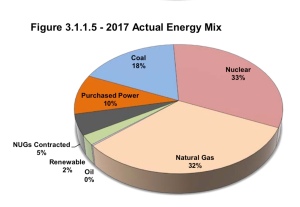
Dominion’s ad would have done a better job of distracting us if it had included baby animals. Their failure is my opportunity! These lambs keep the grass short around the solar panels at a farm near New Hope, Virginia. Owners Ann and Riley Murray shared this picture.
When your kid greets you at the door with the cheery news that he’s swept the floor for you without being asked, you are probably right to wonder which breakable item is no longer in its usual place.
I have the same feeling about the series of full-page ads Dominion Energy has taken out in newspapers over the past few weeks bragging about the company’s investments in solar energy. The ads are misleading—I’ll get to that in a minute—but the more interesting question is what the company is up to that it hopes we’re too busy looking at solar panels to notice.
Here are some possible answers:
• It was recently reported that Dominion Energy paid no federal income tax for 2018, in spite of earning over $3 billion in U.S. income. In fact, the company received a $45 million rebate, making its effective tax rate -1%. That’s pretty sharp manipulation of the tax laws. No wonder CEO Thomas Farrell II is the highest paid executive in the utility sector, with a reported $20.6 million in income.
• Most of that untaxed income comes from customers here in Virginia, but not all of it is earned. Let’s recap just a few of the high points: In 2014, the General Assembly passed a law letting Dominion charge customers for hundreds of millions of dollars incurred in planning for a new nuclear plant the company isn’t building. Then in 2015 Dominion persuaded legislators to “freeze” regulators’ ability to examine the books and order refunds of what turned out to be hundreds of millions more in customer overpayments. Regulators said the number might eventually rise as high as a billion dollars. When grumbling about that reached a fever pitch, Dominion persuaded the still-compliant (!) legislature to pass another billlast year letting it spend the money instead of refunding it.
• After getting authority to spend all that customer money, one of Dominion’s first moves was to interpret “spending” as “keeping.” Instead of the massive spending on energy efficiency that the legislature put into the law, Dominion tried to discount the number by 40 or 50% so it could keep the rest as “lost revenue.”
• Dominion’s Atlantic Coast Pipeline could shape up to be a huge profit center for the company, but also a huge financial burden for utility customers. Dominion fought hard against a bill this year that would have protected customers if and when the pipeline ever gets built. The company eventually defeated the bill in a Dominion-friendly Senate committee, but not before voting revealed deep fault lines in the House.
• Slides from a presentation to an investor meeting in March show Dominion bragging about Virginia having a favorable regulatory environment (read: utilities get their way).
• That presentation caught the interest of several House Democrats for another reason: it boasted customer-funded spending numbers at least $3 billion higher than it gave its regulators at the State Corporation Commission just two weeks before. In a news release May 2, the seven delegates demanded Dominion produce a full accounting of its future spending plans. Del. Elizabeth Guzman, D-Prince William, whose office issued the release, said “Dominion’s days of facing no consequences when telling Virginians one thing and Wall Street another are coming to an end. The SCC is right to uncover Dominion’s inconsistencies and hold the monopoly accountable since it is Virginia ratepayers who will ultimately pay the price.”
• The delegates also noticed Dominion has decided it wants to make even more profit from its Virginia customers. This spring the company asked the State Corporation Commission to raise its rate of return on common equity from 9.2% to 10.75%, an astounding increase at a time of low interest rates and easy access to capital. Dominion may believe that by overreaching, it will win some middle ground. In the March presentation, Dominion told shareholders the company expects to earn an average 10.2% return on equity from its Virginia investments, still a full percentage point higher than the utility is currently authorized to earn.
• The Virginia Attorney General’s Office is fighting Dominion’s attempts to collect $247 million from ratepayers for environmental upgrades at its Chesterfield power plant, calling the spending “imprudent” given that it will provide “little or no value to customers.”
All of this should feel pretty brazen to Virginia leaders and the public, but when you want something you don’t deserve, it helps to be shameless.
Yet at least some Dominion leaders seem to be aware that other people think the company should be ashamed of its greed, and that some of these people are voters who may eject its friendly legislators from office this fall. Their answer is to run an ad about solar panels to distract us and change the conversation.
But the ad just starts its own conversation — and not in the intended way.
The ad brags, “At Dominion Energy, we’ve increased the number of solar panels in Virginia from 5,250 to over 2 million since 2015. And we’re now the 4th largest solar producer in the nation.”
First off, a minor point, but a symptomatic one: that “fourth largest” claim doesn’t hold up. As of last September, a ranking of the largest solar owners put Dominion in 10th place. Even using the updated number (2,600 MW) from Dominion’s March 2019 investor presentation wouldn’t get the company to fourth place unless other companies have been hastily selling off projects. It does appear Dominion can rightly claim to be the fourth largest solar owner among energy holding companies that own electric utilities. But so what?
The Virginia number catches our attention, though. Two million solar panels sounds like a lot. It’s just that — well, somebody check my math here, but if those are average 300-watt panels, that comes out to 600 MW, which is a pitifully small amount compared to Dominion’s fossil fuel investments. We’re glad to have any solar at all, but it isn’t something to write friends in California about (they’ve got 24,000 MW of solar and counting).
Speaking of California, that and North Carolina are where the rest of Dominion’s solar projects are, in case you’re wondering. The laws are better there. Dominion didn’t write their laws.
Also, while we are at it, almost none of the solar Dominion is developing is for ordinary residents, in spite of what the ad implies. Almost all of it is for data centers and other large customers. Dominion is counting the 350 MW of solar it is developing for Facebook towards the commitment it made to the General Assembly last year to develop 3,000 MW of renewable energy by 2022.
Legislators who thought Dominion would build a lot of solar for regular folks when they agreed to last year’s boondoggle bill should find that disappointing. If they didn’t get solar for their constituents, what exactly did they get?
Unfortunately for Dominion, that brings us back to the long list of things the company was hoping we would ignore while we look at bright shiny objects. Ads about solar panels aren’t enough to distract people from the billions of dollars Dominion is taking from our pockets.
Perhaps the executives at Dominion will conclude the ad just wasn’t good enough. Next time they could try putting sheep in the picture with the solar panels. Especially baby sheep.
Maybe they thought about it and were afraid it would remind Virginians they were getting fleeced.
But they had better try something. Because right now, frankly, no one is distracted.
This article first appeared in the Virginia Mercury on May 6, 2019.


